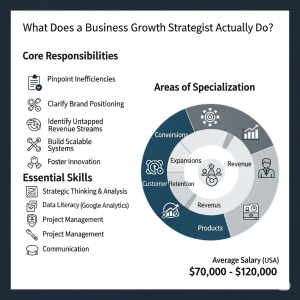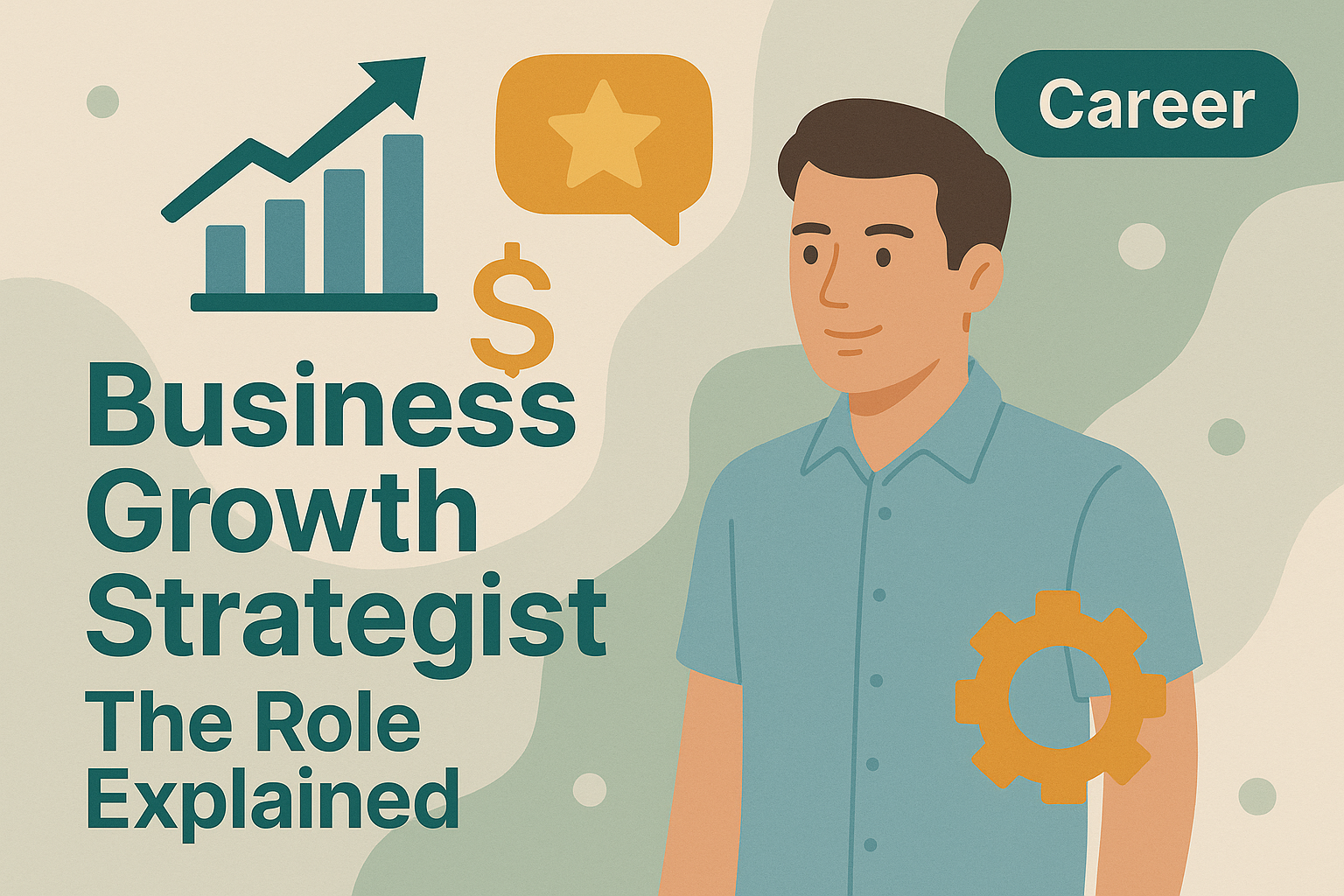Business Growth Strategist – The Role Explained
There are many roles and job titles that may sound unfamiliar. We’ve seen most at business route but one of those that often brings questions is the business growth strategist.
As the name suggests, the function of this role is to analyse performance and devise strategies to help grow different aspects of a business. This may be a growth in revenue, and can cover smaller elements like growing the number of positive reviews.
In this comprehensive guide, you can learn what a business growth strategist does on a day-to-day level, the difference they can make to a company, the strategies they can employ, and what’s needed to qualify and work as a growth specialist.
Let’s begin with the basics.
What Is A Business Growth Strategist?
A business growth strategist creates and designs ideas and plans to help a company grow. This may be growth in profits, or it may be growth in customer retention, to name two examples. The purpose behind their role is to help the business expand, often in a sustainable way.
A growth strategist needs to know and understand the business in question. This way, they can create a practical vision, with measurable steps that align with the company’s values. Oftentimes, this involves thinking long into the future and avoiding short-term revenue spikes.
Ultimately, their aim is to create the best version possible of the company, and that often involves a degree of growth and change.

What Difference Can A Growth Strategist Make To A Business?
There are various ways a growth strategist can help a business. They can, for example, help you pivot into the digital world. They can help give you focus and direction so you have clear and actionable goals. They can even help small businesses achieve fantastic growth.
Armed with data, a good growth strategist has the ability to help:
-
- Pinpoint inefficiencies in operations
- Clarify brand positioning
- Identify untapped revenue streams
- Build scalable systems for marketing and sales
- Foster innovation in product or service delivery, such as implementing artificial intelligence (AI)
In short, a growth strategist can add value by aligning strategy with execution. It’s easy to develop ideas, but making them happen is another thing.
Helping With Digital Growth
If you’re a business owner that has relied on the likes of word-of-mouth or more traditional forms of marketing, you may have an untapped gold mine in your backyard in the form of digital expansion.
Adopting marketing methods like Search Engine Optimization (SEO) and social media can help skyrocket growth. But without experience or at least an understanding of how these things work, a business could lose money rather than gain it.
A good growth strategist can help unlock this potential. Working with marketing, product and tech teams, they can introduce new revenue streams, optimize existing ones, boost visual presence and help grow the overall brand, which can all help to support online customer acquisition and retention.
Business Growth Strategists and Entrepreneurs
Entrepreneurs are known for wearing many hats and for having more ideas than they can action. A business growth strategist could help turn those ideas into a reality.
A strategist offers an entrepreneur strategic guidance and focus, as well as providing a sounding board to develop and refine ideas. They essentially provide the structure to the vision and offer you the route to make the dream a reality.
How Could A Growth Strategist Help A Small Business?
It’s a misconception to believe that business growth strategists only work for wealthy and large companies. Many strategists specialize in helping small and medium-sized businesses (SMEs).
Smaller firms have more pressure in terms of resources, and a strategist can help them identify what to focus on to achieve the most growth possible with what they have available.
As well as this, they can:
-
- Develop lean, high-ROI marketing strategies
- Structure pricing for profitability
- Build customer loyalty systems
- Prepare for scaling infrastructure
If you’re looking to gain a competitive edge as a small business, then working with a strategist to help develop tailored plans could make all the world of difference.
Understanding The Different Types Of Business Growth Strategists
As we’ve touched upon, the role of a growth strategist can be varied, with the ability to focus on and specialise in specific areas of growth.
Let’s take a look at some of the most common types of growth strategists.
Conversions
A conversion strategist is someone who focuses on turning the likes of website visitors or callers into paying customers. They often collaborate with marketing, UX and sales teams to optimise conversion rates by removing obstacles and making the customer experience the very best it can be.
Expansions
One way businesses grow is through purchasing other firms. Those other firms may hold lucrative contracts, employ quality staff, or have existing products or infrastructures in place that can accelerate overall growth.
A growth strategist’s role in this regard is to analyze the market, identify potential opportunities, and create a plan to make it a reality.
Customer Retention
A huge part of achieving business growth is to improve and refine existing practices. If businesses focus on customer experience, they can find it a tremendous way of keeping hold of hard-won clients.
This can be achieved through ongoing loyalty programs, email sequences, or personalized customer journeys.
Revenue
One of the simplest yet most important functions a business growth strategist performs is to boost revenue.
This can be achieved by pursuing various methods, like reviewing pricing models, upselling opportunities, sales processes, and margins.
It can also involve reviewing suppliers and renegotiating different types of expenditure.
Products
A growth strategist may also look to products to help achieve the desired increases. Product-focused strategists often explore ways to expand offerings, such as through new features, bundles, or entirely new product lines.
Greater success is often achieved when methods are based on market research and customer feedback.
What Does An Average Day Look Like?
It may sound easy and obvious on paper, but the role of a business growth strategist is complex. It can also be varied, with different strategists specializing in different niches.
A typical day would involve data analysis and collaborations with others within the business. It can also involve tasks like:
-
- Reviewing analytics dashboards – this can relate to marketing streams and campaigns to identify returns on investment and conversion rates
- Running A/B tests – this type of testing involves serving customers with different versions of the same thing to see which one gains more interactions. This knowledge is vital to help you understand how customers behave with the brand and its platforms so that you can improve the conversion rate
- Meeting with marketing, sales, or product teams – communication and collaboration are key to implementing strategies.
- Refining strategic plans – if existing plans exist, a strategist can help refine and improve them.
- Researching competitors and market trends – it’s vital to understand the market and what competitors are doing. A good strategist will be aware of any new changes to the industry
- Preparing reports for leadership – providing feedback on progress is vital for leadership to understand what’s working and what’s not
How Do You Become A Growth Strategist?
Now you know what a business growth strategist does and what an average day looks like for them, you may wish to know what the process is like to become one.
There are certain skills that are required to succeed. A solid understanding of marketing and business development will help. Depending on the type of strategist you want to be, an understanding of product management may also be vital.
Above all, it’s vital to be able to collect and analyse data from a range of sources, be it interviews and surveys or technical reports on website behavior.
What Qualifications and Skills Do You Need?
Although not mandatory, a degree in business, marketing, or economics can be helpful to you in achieving your goals of becoming a strategist.
More importantly, successful strategists typically possess:
-
- Strategic thinking and critical analysis – being able to analyse and critique information is vital, and then strategically planning based on that is even more important.
- Data literacy (e.g. using tools like Google Analytics, Excel, Tableau)
- Project management – the ability to communicate and work with a large team is vital.
- Familiarity with growth frameworks (e.g. AARRR funnel, OKRs)
- Communication and stakeholder alignment skills – this way, everyone is kept informed of any new changes
How Much Do Growth Strategists Earn?
Before you set out to study and qualify as a business growth strategist, it helps to know what they earn
On average in the US, business growth strategists typically earn between $70,000 and $120,000 per year, depending on their experience, industry, and location.
Key Takeaways
-
- A business growth strategist helps companies identify and act on strategic opportunities for growth.
- They work across departments and channels—online and offline—to drive performance.
- There are specialized roles in conversion, acquisition, retention, revenue, and product growth.
- Growth strategists are particularly valuable to entrepreneurs and small businesses who need focused, expert input without building large teams.
- Career paths are varied, but success in the role relies on strategic thinking, analytics, communication, and a deep understanding of customer behavior.
Business strategists can hugely help any growing business. You can find more articles that can help you and your business grow, scale and excel here on business route.

